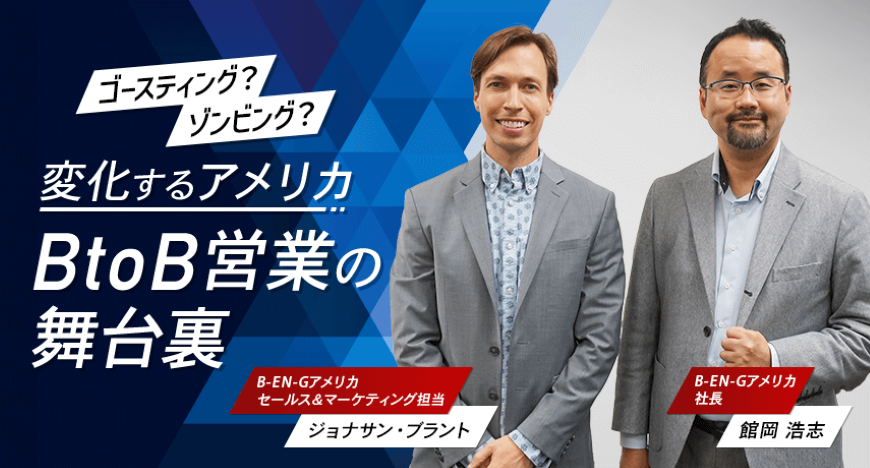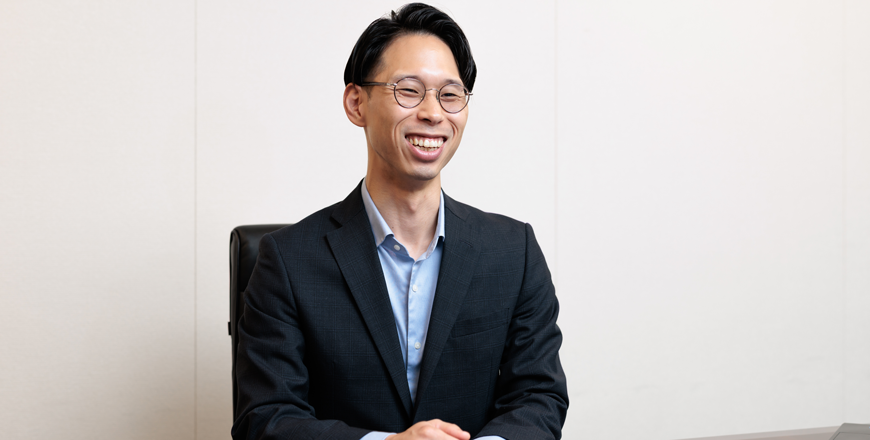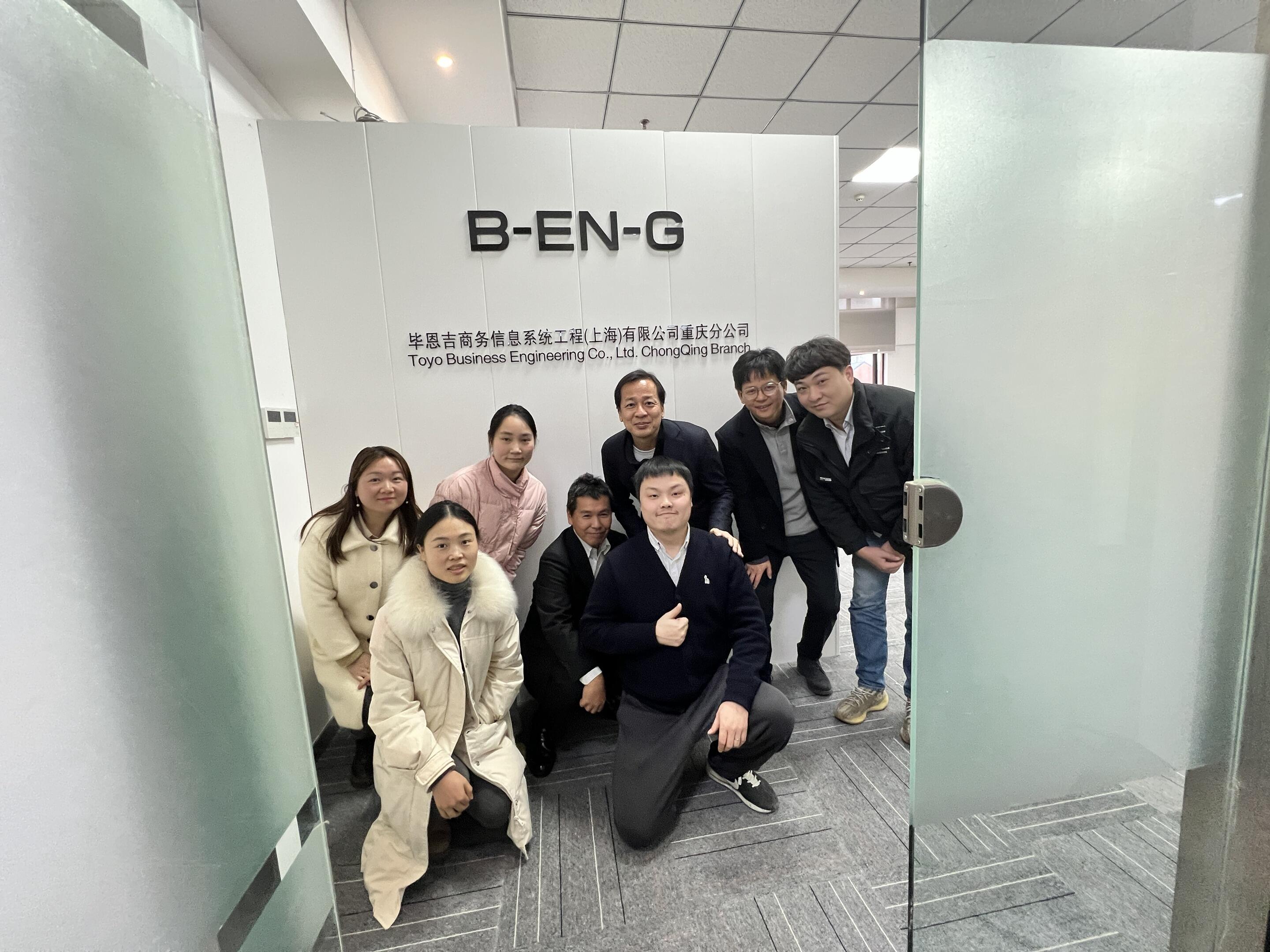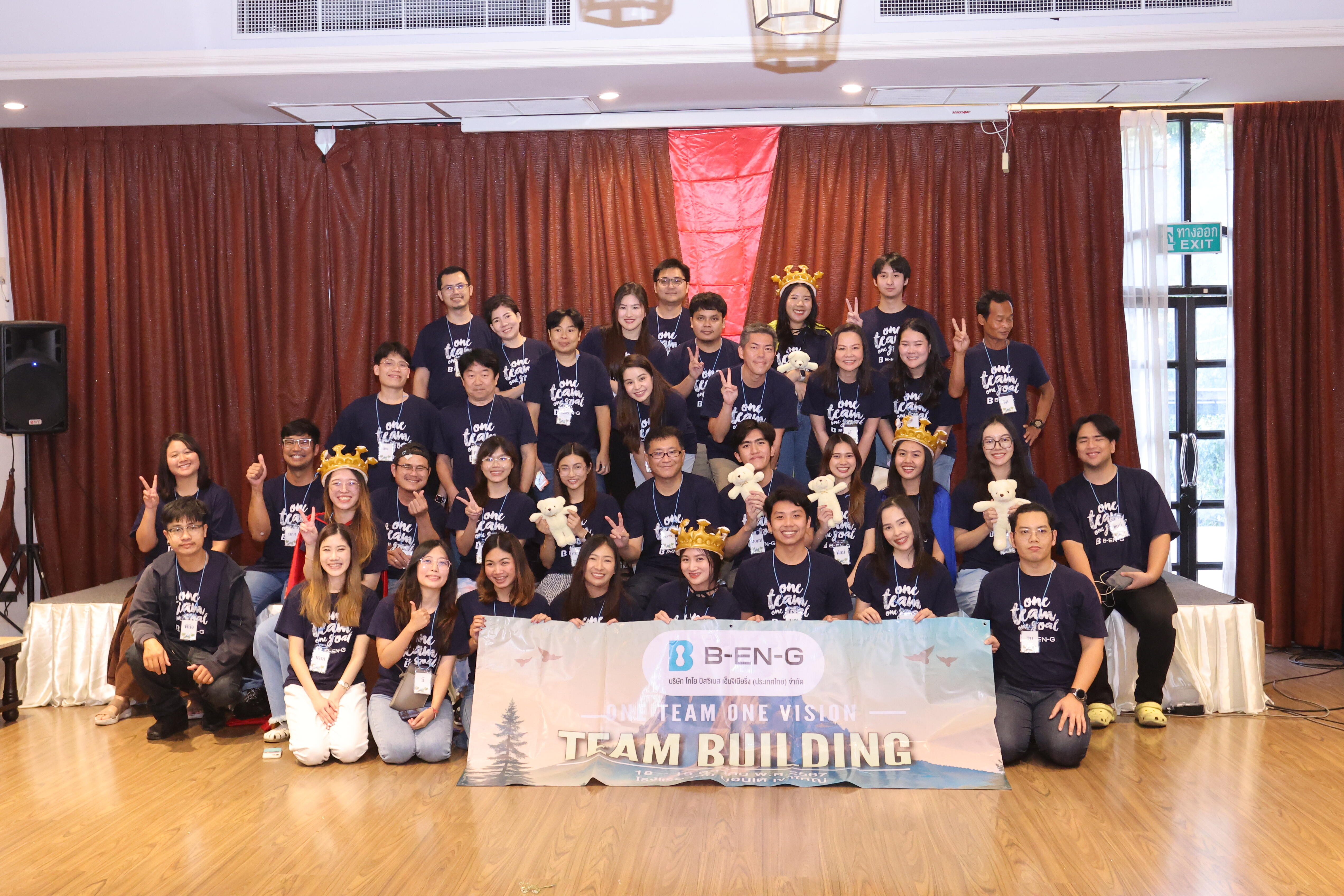How do you sell your products in the US market and get your business on track? As of 2023, the US boasts the world's highest gross domestic product (GDP), so developing the huge market is an old and new business challenge. In the midst of this,B-EN-G America, a US subsidiary of the Business Engineering Group established in 2017, has been achieving results by proposing IoT solutions for the manufacturing industry originating from Japan. We spoke to two local key people about the cutting edge of sales activities in the US and the trends that are currently being explored.

Increasing need for small starts
-First, please tell us about the work you both do.
Jonathan Brandt (hereinafter Jonathan): As a sales and marketing specialist, I am mainly working on proposing "mcframe SIGNAL CHAIN" (hereinafter SIGNAL CHAIN), an IoT solution with functions such as factory operation monitoring and equipment maintenance. I also travel to various exhibitions held across the US as an exhibitor.
Hiroshi Tateoka (hereinafter referred to as Tateoka): I have been the representative of B-EN-G America since 2018. Before joining the company, I was in the New Product Planning Department, where I planned IoT tools that would help improve production sites using IoT technology, which was a trend at the time. As an extension of that, I have been working on the mission of spreading Japanese IoT solutions such as SIGNAL CHAIN in the US.
--What are the needs of American manufacturing that you have noticed while doing B2B (business-to-business) sales, and what are the differences between them and Japan?
Jonathan: When proposing a system, I feel there is a strong tendency for it to be simple so that the people on the front lines can quickly master it. In American factories, people with diverse backgrounds and educational backgrounds work, so if the system is too sophisticated and complicated, they may not be able to use it properly. Also, in the United States, people change jobs all the time, so I feel there is a tendency to prefer solutions that can be mastered quickly and can be listed on a resume as an achievement or skill.
Tateoka: In Japan, products and services tend to become more complex in response to customer requests, and they tend to come with many thick manuals. But imagine if you bought an iPhone from Apple in the US, it didn't come with a thick manual. I think there is a tendency for simplification in the US, whether it's BtoB or BtoC (for consumers).
--I certainly feel that there are differences. How did B-EN-G America adapt to the American market?
Mr. Tateoka: From the very beginning, mcframe IoT products that utilize IoT technology have been developed to be intuitive to use without having to read the manual, with a UI (※1) and UX (※2) that would be easy to use globally.
Jonathan: American customers were worried about the support they could get from Japanese companies, whether they could speak English properly, and whether they could receive the advice they needed. So even if there was no need, we made efforts to visit our customers frequently to build relationships and reassure them.
*1 UI (User Interface) = the point of contact where information is exchanged between the user and the computer
*2 UX (User Experience) = The experience that users gain through using a product or service
--Please tell us the key points you take note of when selling your system proposals.
Tateoka:DX is progressing in the United States, but no model cases have been established in the manufacturing industry yet. Therefore, rather than making large-scale initial investments with a large budget, the preferred style is to start small and try and error to find the right answer while increasing the number of attempts. When selling systems in the United States, I think it is better to have an idea that meets the needs of small starts, at least in the manufacturing industry.
Good response in person…then no contact later
--Please tell us about the difficulties of sales activities in the United States.
Jonathan:The first thing that comes to mind is a phenomenon called ghosting. The word is derived from the word ghost, and refers to someone suddenly disappearing and becoming unreachable. When you meet someone at an exhibition or other event, they respond well, saying things like "I like it" or "It's interesting," and then as you continue to communicate with them about introducing the product, they suddenly stop replying to your emails and your phone goes to voicemail. Sometimes you can't get in touch with them when deciding on the date for on-site introduction, and it makes you worry that something has happened.
However, what's interesting is that sometimes after one or two years, they suddenly contact us saying, "I want to buy your product after all." This phenomenon is called zombieing, likening it to a zombie. Recently, we received an inquiry from a company that we had contact with several years ago. When the time comes, customers will move quickly, so it's important to have a system and mindset that allows you to resume sales immediately.
-What insights have you gained from selling SIGNAL CHAIN in the US?
Tateoka:SIGNAL CHAIN is an IoT solution for the manufacturing industry that comes as a set of software and hardware. For example, the signal lights that notify of equipment abnormalities are made by Patlite, a leading manufacturer in Japan. They have been highly praised for many aspects, such as their high visibility, which makes them easy to see even in dimly lit factories, and their easy-to-hear alarm sounds.
Japanese hardware tends to be popular overseas, so by packaging software with hardware rather than just selling it alone, Japanese companies can make the most of their strengths and appeal to customers.
Jonathan:As an approach to meet the needs of those looking to start small, we offer a quick start kit for the US market. Customers can use SIGNAL CHAIN in a minimal configuration, and if they like it, they can order additional equipment licenses. We also offer demonstrations so customers can actually touch and experience it, which gives them peace of mind and leads to additional orders.
--It's true that American services seem to have a lot of trial information all over their websites. What do you think about customer evaluations of Japanese IT products?
Tateoka:There were two popular terms in the past: "offensive IT" and "defensive IT." The former is an initiative that aims to transform business models and increase profits and sales by utilizing IT, while the latter is an initiative that achieves cost reduction and efficiency without changing existing business models.
Our impression of US clients is that they prefer an approach that fundamentally solves problems by making major changes to business models from an offensive IT perspective. Initially, it was difficult to propose SIGNAL CHAIN, which is a defensive IT solution, but with the COVID-19 pandemic causing historic turnover rates, labor shortages, and rising labor costs, it has become important to quickly streamline operations. There is a common understanding that utilizing IT can help with this, so we feel that it is becoming more readily accepted in the US.
--So defensive IT is being reconsidered in the changing times. What changes are you seeing among American business people?
Tateoka:I feel like people don't say "no" as much these days. Even at trade shows, they'll say positive things like "this product is exactly what I was looking for," but they almost never say negative things like the price is high. Because of this, I feel like salespeople in the U.S. are now being asked to "read the air," as we call it in Japan, by not being swayed by superficial words, but by reading the true intentions of customers and presenting benefits and information that will lead to solving the problems they are facing.
"Ghosting" and "zombie" are examples of this, but in order to discern the customer's true intentions, it is important to visit and contact them multiple times while the relationship is good, and to understand the customer's situation for yourself.
"Support that goes a step further"
--Please tell us about how you will be able to serve U.S. customers after the contract is concluded.
Mr. Tateoka: In the United States, there is a culture of doing things yourself as much as possible when introducing a system, rather than outsourcing. Therefore, it is necessary to provide support that allows the customer's information systems department to deal with the problem without stress. If you provide a formulaic response, the customer will be put off. It is important to understand the situation and provide support that goes one step further.
--If you were to set up a full-fledged support team in the United States, wouldn't labor costs and other expenses be considerable?
Tateoka: The United States is a vast country, so there has always been a high tolerance for remote work, but I think it has become even more common since the COVID-19 pandemic.
In response, N-PAX Cebu Corporation (※3), a Philippine IT company in which Business Engineering has a capital participation, provides support tailored to US time at reasonable prices, and B-EN-G is working to create a global support team that includes its Japanese headquarters.
For example, if a customer in the United States asks a detailed question about a product, if the question is posed to the Japanese side in the evening, a response can be prepared in Japan during the middle of the night in the United States, and the response can be given to the customer in the morning. As a result, we are able to make effective use of the time difference.
*3 N-PAX Cebu Corporation: A company with over 20 years of experience in providing IT services such as building ERP (enterprise resource planning) systems in the Philippines. In June 2023, Business Engineering made an additional investment, raising its investment ratio to 13.57%.
(Source) https://www.b-en-g.co.jp/jp/news/2023-06-01-news.html
--Does your position as a Japanese company give you an advantage in your sales activities in the United States?
Jonathan: Initially, we wanted to give the impression that we were a global company, so we tried not to show any Japanese elements at exhibitions and other events. However, as we interacted with customers, we often had them say, "A Japanese company is trustworthy," so we started to emphasize that we were a Japanese company.
Tateoka: Major League Baseball player Shohei Ohtani became famous for the helmet he wears when he hits a home run, but even before that performance began, we had been putting helmets on the signal lights of IoT devices at our product exhibits. Japanese culture is popular, and such icebreakers that lighten the mood have also been useful in business negotiations.
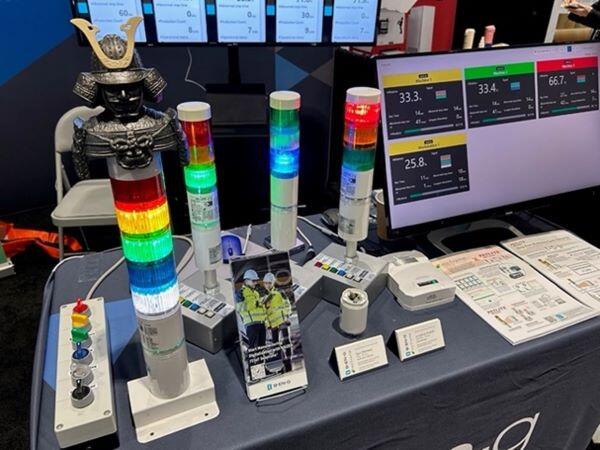
A look at the exhibition booth. Kabuto helmets are used to promote Japanese brands.
"Who has the budget?" Digital Transformation in the US
--Please tell us about the challenges you are currently facing in B2B sales in the United States.
Tateoka: Speaking of sales related to DX, one of the concerns is that it is difficult to see who has the authority to decide the budget. Will DX be led by the business department or the information systems department? Some customers have departments that specialize in DX. We conduct sales while exploring who we should approach to get the budget.
Jonathan: As Tateoka mentioned, it is difficult to see who has the authority to decide the budget, so we try to gather as many internal members as possible when we do demonstrations and proposals. If we know who the key people are, a small number of people is preferable, but the idea is to reach as many people as possible while narrowing down the target.
--Please tell us what kind of sales activities you plan to carry out in the future.
Tateoka: In a rapidly changing environment, such as the COVID-19 pandemic, the subsequent era of job changes, and historic price increases, I think that depending on the business situation of our customers, it may be difficult to take on large-scale initiatives. I feel that there is a change in which the strengths of efficiency tools that can be quickly implemented and produce results are being recognized.
It is almost certain that DX, including the use of AI, will become more widespread in the future. We would like to propose using IoT solutions to start accumulating the data necessary for DX now. We will work with our customers to overcome the current difficulties and contribute to their business with an eye to the future.
(Text: Kyodo News Digital)
*This article is current as of November 2023.
